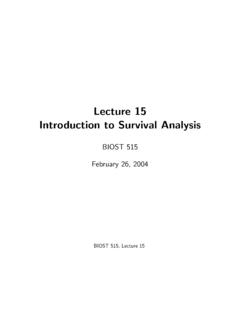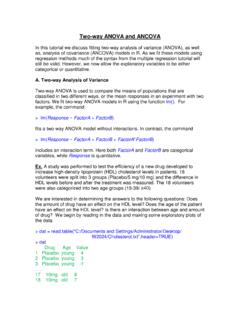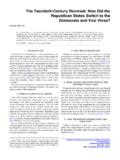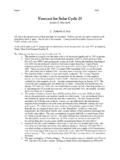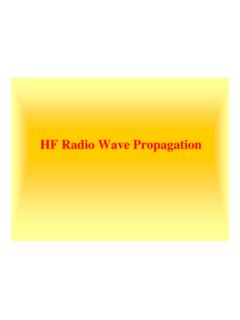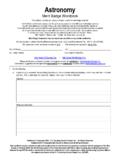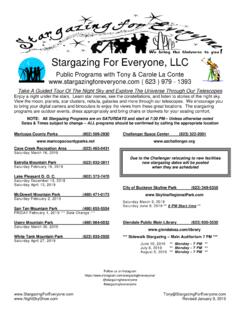Transcription of Putting it all together Richard A. Davis - Columbia University
1 1 Outline Modeling objectives in time series General features of ecological/environmental time series Components of a time series Frequency domain analysis-the spectrum Estimating and removing seasonal components Other cyclical components Putting it all togetherIntroduction to Statistical Analysis of Time SeriesRichard A. DavisDepartment of Statistics2 Time Series:A collection of observations xt, each one being recorded at time t. (Time could be discrete, t = 1,2,3,.., or continuous t> 0.)Objective of Time Series Analaysis Data compression-provide compact description of the data. Explanatory-seasonal factors-relationships with other variables (temperature, humidity, pollution, etc) Signal processing-extracting a signal in the presence of noise Prediction-use the model to predict future values of the time series3 General features of ecological/environmental time Mauna Loa (CO2,, Oct `58-Sept `90)CO21960197019801990320330340350 Features increasing trend (linear, quadratic?)
2 Seasonal (monthly) to ITSM Demo2. Ave-max monthly temp (vegetation=tundra,, 1895-1993)Features seasonal (monthly effect) more variability in Jan than in Julytemp020040060080010001200-5051015205 temp0 20406080100-505101520 July: mean = , var = .6305 Jan : mean = , var = 20406080100151617181920 Sept : mean = , var = : + .00845 t6 Components of a time seriesClassical decompositionXt= mt+ st+ Yt mt= trend component (slowly changing in time) st= seasonal component (known period d=24(hourly), d=12(monthly)) Yt= random noise component (might contain irregularcyclical components of unknown frequency + other stuff).Go to ITSM Demo7 Estimation of the mt+ st+ Yt12/) (. 6556++ ++++=tttttxxxxm kkttataam+++= 10 polynomial fittingTrend mt filtering. , for monthly data use8 Estimation of the components (cont).Xt= mt+ st+ Ytyears ofnumber ,/)( 2412=++=++NNxxxstttt )122sin()122cos( tBtAst + =Irregular component YtttttsmXY =Seasonal st Use seasonal (monthly) averages after detrending.
3 (standardize so that stsums to 0 across the year. harmonic components fit to the time series using least example. (n=6)/sqrt(3))' )662(cos ,),62(cos(1 =..c/sqrt(3))' )6622(cos ,),622(cos(2 =..c/sqrt(6)' )622(cos ,),22(cos(3 =..c/sqrt(6))' )6602(cos ,),602(cos(0 =..c/sqrt(3))' )662(sin ,),62(sin(1 =..s/sqrt(3))' )6622(sin ,),622(sin(2 =..sc0c1s1c2s2c3xX=( , , , , , ) X=( , , , , , ) = 2c0+5(c1+s1) (c2+s2)+.5c3 The spectrum and frequency domain analysis10 Fact:Any vector of 6 numbers, x = (x1, .. , x6) can be written as a linear combination of the vectors c0, c1, c2, s1, s2, generally, any time series x = (x1, .. , xn) of length n (assume n is odd) can be written as a linear combination of the basis (orthonormal) vectors c0, c1, c2, .., c[n/2], s1, s2, .., s[n/2]. That is,]2/[ ,111100nmbabaammmm=++++=scsccx = = =)sin()2sin()sin(2 ,)cos()2cos()cos(2 ,11112/12/12/10jjjjjjjjnnnnn scc11 Properties:1.))
4 The set of coefficients {a0, a1, b1, .. } is called the discrete Fourier transform]2/[ ,111100nmbabaammmm=++++=scsccx === == ====ntjtjjntjtjjntttxnbtxnaxna12/12/112/ 12/112/100)sin(2),()cos(2),( 1),(sxcxcx12() ==++=mjjnttbaax1j222012 2. Sum of ANOVA (analysis of variance table)Source DF Sum of SquaresPeriodgram 01a02I( 0) 1=2 /n2a12 + b122I( 1) m =2 m/n 2am2 + bm22I( m) n ttx2 13 Source DF Sum of Squares 0=0 (period 0) 1a02 = 1=2 /6 (period 6) 2a12 + b12= 2 =2 2/6 (period 3) 2a22 + b22 = 3 =2 3/6 (period 2) 1a32 = 6 = to toy example ttx2 Test that period 6 is significant H0: Xt= + t , { t} ~ independent noise H1: Xt= + Acos (t2 /6) + Bsin (t2 /6) + tTest Statistic:(n-3)I( 1)/( txt2-I(0)-2I( 1)) ~ F(2,n-3)(6-3)(50/2)/( )= p-value =.
5 003 14Ex. Sinusoid with period ,,2,1 ),122sin(3)122cos( + =tttxtITSM DEMOThe spectrum and frequency domain analysisEx. Sinusoid with periods 4 and Mauna Loa15 Sometimes, a seasonal component with period 12 in the time series can be removed by differencing at lag 12. That is the differenced series is .120,,2,1 ,)122sin(3)122cos( + + =tttxttDifferencing at lag 1212 =tttxxyNow suppose xtis the sinusoid with period 12 + has correlation at lag = =tttttxxy16Ex. Sunspots. period ~ 2 /.62684= years Fisher s test significanceWhat model should we use?ITSM DEMOO ther cyclical components; searching for hidden time series {Xt} is whiteor independent noiseif the sequence of random variables is independent and identically 20406080100120-2024 Battery of tests for checking ITSM, choose statistics => residual analysis => Tests of Randomness18 Residuals from Mauna Loa {t+1} (Xt, Xt+1) =.
6 824t rtrt+ {t+1} (Xt, Xt+2) = .736t rtrt+ rtrt+ {t+1} (Xt, Xt+3) = .654x_tx_{t+1} (Xt, Xt+25) = .074t rtrt+ .. function (ACF):Mauna Loa residualslagACF0 noiseConf Bds: (n)20 Putting it all togetherExample: Mauna LoaCO21960197019801990320340trend1960197 019801990320340seasonal1960197019801990- 3-11 2 3irregular for modeling the irregular part {Yt}. Fit an autoregressive process Fit a moving average process Fit an ARMA (autoregressive-moving average) processIn ITSM, choose the best fitting AR or ARMA using the menu option Model => Estimation => Preliminary => AR estimationorModel => Estimation => Autofit22 How well does the model fit the data?1. Inspection of they compatible with white (independent) noise?
7 No discernible trend no seasonal component variability does not change in time. no correlation in residuals or squaresof residualsAre they normally distributed?2. How well does the model predict. values within the series (in-sample forecasting) future values3. How well do the simulated values from the model capture the characteristics in the observed data?ITSM DEMO with Mauna Loa23 Model refinement and Simulation Residual analysis can often lead to model refinement Do simulated realizations reflect the key features present in the original dataTwo examples Sunspots NEE (Net ecosystem exchange).Limitations of existing models Seasonal components are fixed from year to year. Stationary through the seasons Add intervention components (forest fires, volcanic eruptions, etc.)24 Other directions Structural model formulation for trend and seasonal components Local level modelmt=mt-1+ noiset Seasonal component with noisest= st-1 st-2.
8 St-11+noiset Xt= mt + st+ Yt+ t Easy to add intervention terms in the above formulation. Periodic models (allows more flexibility in modeling transitions from one season to the next).
